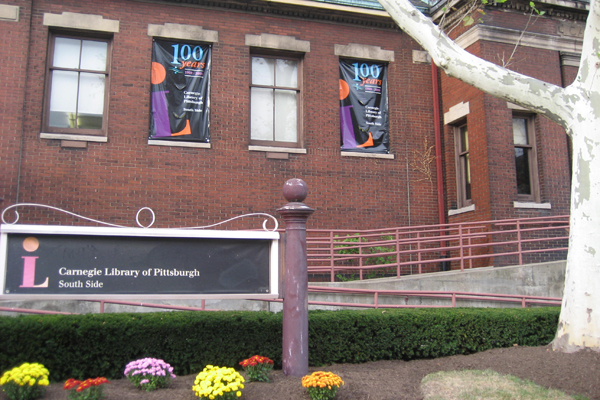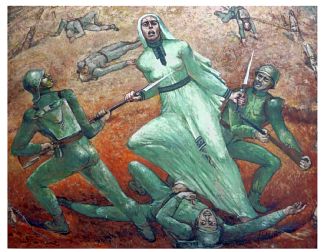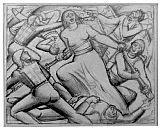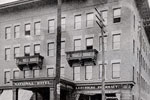
Category Archive: Historic Properties
-
Carnegie Library Approves Plans to Renovate Historic South Side Branch
Wednesday, November 03, 2010
Pop City Media
The Carnegie Library of Pittsburgh Board of Trustees has unanimously agreed to make plans to renovate the South Side branch a top priority with funding to come from the Libraries for Life capital campaign that has set aside $2.7 million for renovating the aging building.
“The South Side does not have air conditioning and it’s a little over 100 years old. It’s not compliant with the guidelines of the Americans with Disabilities Act,” explains Suzanne Thinnes, communications manager for the Carnegie Library. “We find that when libraries are renovated they bring a new excitement to the community. More people discover the library and we see our circulation and account numbers go up.”
While the renovation process is in its early stages and an exact date for the project’s completion is currently ambiguous, a community meeting is scheduled at the South Side branch on November 17 at 6 p.m. to hear from the community about what they’d like to see preserved and changed about the library. Karen Loysen of Loysen + Kreuthmeier is the architect for the project and the upcoming meeting marks the start of a public dialogue that will create a vision for the library hoping to satisfy as many people as possible.
Writer: John Farley
Source: Suzanne Thinnes, Carnegie Library of Pittsburgh -
Condemned Larimer Building Wins Reprieve
By Adam Brandolph
PITTSBURGH TRIBUNE-REVIEW
Tuesday, November 2, 2010An Allegheny County judge put a temporary halt on the city’s plan to demolish a condemned property in Larimer after a Sharpsburg man said he wants to restore it.
John Cobb plans to rehabilitate a 110-year-old building at 16 Shetland St. to use as an investment property, said his attorney, Matthew L. Kurzweg. Cobb, who applied for permits to reverse the condemnation after the judge’s decision on Friday, declined comment.
“From my understanding, the building is pretty structurally sound,” Kurzweg said Monday.
Common Pleas Judge Robert Colville said the city could demolish the building after Feb. 1 if Cobb fails to show progress on the rehabilitation.
Pittsburgh building inspection officials said the property is in bad condition but don’t believe the city will appeal the judge’s decision. City Solicitor Dan Regan could not be reached for comment.
Sherry Hickson, 72, a longtime Larimer resident, said the building needs to go.
“If it’s in bad condition, it could pose a threat to everyone around it,” Hickson said.
Neighbor Robert S. Brown said he would like to see the building restored.
“There are so many places where every building is torn down, and it looks ugly,” Brown said. “If this guy wants to try to restore it, they should let him.”
The building is one of many slated for demolition. Mayor Luke Ravenstahl budgeted $3.04 million to level condemned buildings this year, including $2.19 million in city money and $850,000 in federal dollars.
-
Physician Offers to Move Historic House in Mercersburg
Tuesday, November 02, 2010By Len Barcousky, Pittsburgh Post-Gazette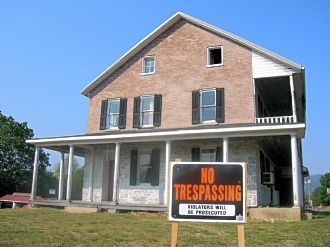
The Smith House is located next to the MMP&W Volunteer Fire Co. The board that oversees the fire company says it needs the land to expand its aging facilities. Len Barcousky/Post-Gazette
A Franklin County doctor has offered to relocate the historic Justice William Smith House in Mercersburg.
“I have a love of history,” Paul Orange said Monday.
He was reluctant to provide too many details of his proposal, but he said he was prepared to cover the costs of moving the two-story structure to a new location. Those expenses, including the cost of acquiring a suitable alternate property, could run as high as $100,000.
Dr. Orange has a family practice along Route 30 in Fayetteville, which is between Chambersburg and Gettysburg. He said he moved to the area in part because of its ties to important events during the Civil War. He is a graduate of Greensburg Central Catholic High School and St. Vincent College. After graduating from medical school at the American University of the Caribbean, he did his residency at Latrobe Hospital.
The Smith House is located next to the MMP&W Volunteer Fire Co. on Mercersburg’s Main Street. The board that oversees the fire company says it needs the land on which the house sits to expand its aging facilities, and it has sought bids for demolition of the building. Its initials stand for Mercersburg, Montgomery, Peters and Warren, which are the communities it serves.
The bids are to be opened Thursday, but the fire company has not said when it will award the contract.
Dr. Orange said he has submitted an offer to move the structure, which would save the fire company the expense of tearing it down.
His proposal has gained the support of a small citizens group, the Committee to Save the William Smith House, which has sought to head off any demolition plans.
“This is an amazing turn just when I thought we were dead in the water,” said Karen Ramsburg, who heads the Smith House committee. “I’m surprised and excited.”
One potential new home for the 18th-century building is the nearby site of a former gas station owned by the First National Bank of Mercersburg.
“The best-case scenario would be to keep the house in its current location,” Ms. Ramsburg said. “Moving it across the street would be the next best thing.”
In 1765, the Smith House was the meeting place for mainly Scotch-Irish settlers who organized themselves into a militia for defense against Indian raids.
Their efforts morphed into attacks on British supply trains and a siege of a nearby British military base called Fort Loudoun. Those early instances of armed resistance took place eight years before the Boston Tea Party and 10 years before the battles of Lexington and Concord.
“It could be said that people in this house provided the spark for the American Revolution,” Dr. Orange said.
Architectural details and property records indicate that the house was built between 1751 and 1759, which includes a portion of the French and Indian War. Porches and a second story were added during the 19th and 20th centuries.
The structure’s connection to the region’s early Scotch-Irish settlers has drawn the attention of an outdoor museum in Northern Ireland.
The Ulster American Folk Park has been working on plans to take apart the 18th-century “historic core” of the stone structure, ship it to Europe and reassemble it outside Belfast.
The folk park already has several other buildings from southwestern Pennsylvania with links to Scotch-Irish immigrants who settled here.
Members of the group seeking to save the house have said relocation to Northern Ireland was a better option than demolition, but they would prefer to have it remain in Franklin County.
Mercersburg is about 150 miles southeast of Pittsburgh.
-
South Side Real Estate Board Says Mission Accomplished
Monday, November 01, 2010By Diana Nelson Jones, Pittsburgh Post-Gazette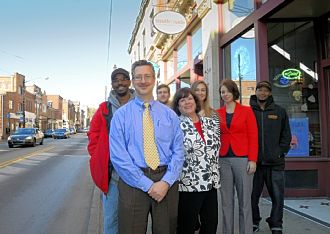
From left, Ron Goings, Rick Belloli, Aaron Sukenik, Judy Dyda, Rachael Glasder, Susie Puskar and DaVar Cutler of the South Side Local Development Co. -- Lake Fong/Post-Gazette
South Side Local Development Co., one of the most successful nonprofit real estate developers in Pittsburgh, will spend the next 18 months putting itself out of business.
The board decided to dissolve the little company whose 28-year tenure on the South Side has coincided with the neighborhood’s transformation in private property values, popularity and market economy.
A successor organization with a focus on public issues will be formed with community feedback to the South Side Planning Forum, the neighborhood’s umbrella for other groups, and the Pittsburgh Partnership for Neighborhood Development.
“This is an exciting transition, and I’m thinking of this as a huge success story,” said Ellen Kight, executive director of the Pittsburgh Partnership for Neighborhood Development. “They have really done what a (community development corporation) is supposed to do.”
Successful development corporations step in with public investment to help neighborhoods attract private investment. Some also have youth and job training programs, public safety committees and other outreach. The South Side nonprofit has largely focused on real estate and has built or renovated more than 100 homes in the past 20 years.
Private developers have added some 800.
“We’ve done our job,” said Tracy Myers, the company’s board president.
In 1982, when the company was founded, property values were two-thirds of the city’s median value, said executive director Rick Belloli. In 2008-09, those values were 170 percent of the city’s median. About 50 percent of the retail space along East Carson Street was vacant in 1982, and that rate is now at about 10 percent, he said.
Rob Stephany, executive director of the Urban Redevelopment Authority, said there is still work to be done by a high-capacity real estate nonprofit in the South Side’s adjacent neighborhoods.
“The target area is big, and the next step would be moving that [real estate] strength to the next frontier,” including Allentown and Arlington, he said.
“Clearly from a real estate value standpoint, the [development company] has been an invaluable piece of the puzzle,” he said. “The equity senior citizens have in their homes is growing, and that’s a proud moment. The fact that there are $400,000 sales in the South Side astounds me to this day.”
The remaining challenges largely have to do with the proliferation of bars, said Ms. Myers. “That’s a consequence of our success.”
The East Carson corridor’s accumulation of liquor licenses is considered to be at saturation by most stakeholders. Uncivil and drunken behavior on weekend nights has some homeowners at the breaking point. Resident Thomas Kolano said he is “very concerned a lot of people are actually talking about leaving the neighborhood.”
“If there isn’t a push-back from residents, this could become an undesirable place to live,” he said. “Sunday through Wednesday and some Thursdays it functions as a normal neighborhood — beautiful and vibrant. I love it. But Friday and Saturday are crazy. It’s like Jekyll and Hyde.”
The city has cracked down on parking violations in recent weeks, and Councilman Bruce Kraus has held several meetings to promote a management strategy for Carson businesses.
Mr. Stephany said a neighborhood improvement district “is an essential next step. The only way to correct some of the issues there is to have collaborative problem solving.”
A neighborhood improvement district is like a business improvement district, except it includes interests beyond those of businesses, such as parks. Participants pay a fee to have the interests of their stated district managed and maintained. The Pittsburgh Downtown Partnership is one example of a business improvement district.
A management strategy for East Carson businesses was recommended several years ago by consultants from the International Downtown Association. A committee of the South Side Planning Forum is gathering feedback to determine the range of focus of the successor organization.
The Pittsburgh Partnership for Neighborhood Development paid for an employee to go door-to-door to gather that feedback. The staff of the local development company will not be involved in the successor agency, although some of its board may be.
Ms. Myers said that while winding down, the agency “still has properties and buildings we want to make sure are well cared for. Some entity needs to keep an eye on these things, to protect all the progress we’ve made to improve the physical environment” and ensure that developers follow historic guidelines.
“Some things we do will have to be done by someone else or not get done,” she said. “The community has to set its priorities.”
-
Vanka’s Art Garnering More Attention
Wednesday, October 27, 2010By Mary Thomas, Pittsburgh Post-GazetteResidents often know of special places in their towns that don’t make it into tour books, from the eye-popping taxidermy in the back of Joe’s Bar in Ligonier to the best crab shack between D.C. and Baltimore.
A Pittsburgh secret that’s beginning to gain a wider reputation is St. Nicholas Croatian Catholic Church in Millvale. The nondescript little church is perched on a hillside in full view of thousands of Route 28 commuters, but few of them have seen the treasure inside.
That’s changing as more people learn about it through public programs such as the current exhibition, “Paintings and Works on Paper by Maxo Vanka,” at Pittsburgh Center for the Arts.
Maximilian “Maxo” Vanka (born 1889, Zagreb, Austria-Hungary; died 1963, Puerto Vallarta, Mexico) painted the murals that cover the interior of St. Nicholas in 1937 and 1941 as his way of expressing gratitude to his “adopted land.” What elevates them above traditional church murals is his incorporation of nationalistic and political subject matter.

Maxo Vanka mural "The Battlefield." The mural is at St. Nicholas Croatian Catholic Church in Millvale.
The center exhibition comprises 47 works by Mr. Vanka on loan from his descendants, the Brasko family in eastern Pennsylvania, including most significantly some of the drawings and paintings that were preparatory for the Millvale murals. These illustrate the compositional permutations Mr. Vanka tried out as he developed ideas and configured them for available spaces.
The works also show that he was an excellent draftsman, as in a beautifully realized sketch of a torso, or pencil drawings of scenes in New York’s Depression-era Bowery. Paintings range from a tender large family portrait of his wife and young daughter (he’s present as a reflection in a carefully placed mirror) to a gruesome anti-war protest parade.
While some of his themes, such as labor and family, were present in Works Progress Administration murals, Mr. Vanka’s Millvale works “contain a moral intensity and socially critical perspective not generally found in the idealized image of America that emerged within much of WPA art,” Barbara McCloskey, associate professor of art history, University of Pittsburgh, wrote in an essay for the nonprofit Society to Preserve the Millvale Murals of Maxo Vanka.
Dr. McCloskey also recommended Heidi Cook, a graduate student in Pitt’s Department of the History of Art and Architecture, to the society when it was looking for someone to catalog Mr. Vanka’s artworks and archives stored at the family home. Ms. Cook spent two weeks this summer in residence there, making notes about each work she uncovered, including size, inscription and label information when present, and condition, and photographing it. She then spent several more weeks in Pittsburgh to enter that information into a digital database.
She estimates there are approximately 1,000 artworks, including paintings, works on paper and sketches in storage, and that she was able to catalog about 20 percent during her stay. Ms. Cook observed that Mr. Vanka was “really prolific” and that he continued to paint throughout his life. She noted many smaller works, including still lifes and landscapes, possibly made to keep in practice, and large-scale paintings inspired by world travels with his wife, including of festivals in Japan and Bali. A powerful and disturbing painting inspired by an Indian leper colony is in the center’s show.
“What’s wonderful about the house,” Ms. Cook said, “is that there are photographs of when Vanka and his wife lived there, and it looks the same. The art is hung in the same places. The furniture is what he brought from Croatia. There are books that he used during his education.”
Ms. Cook initially intended to study modern German art, but her experience with Mr. Vanka has her considering the broader topic of Central and Eastern European art. She’s researching traditional folk costume — something Mr. Vanka incorporated to make political commentary — for her master’s thesis.
There is intent to catalog the remaining works, but that is dependent upon the society finding funding to do so. I hope that happens because such projects bolster knowledge about the artist and are essential steps to ensuring the art’s survival. Word-of-mouth equity can go only so far.
Three paintings by Mr. Vanka’s great-granddaughter, Marissa Halderman, that are responses to particular works of his, are also exhibited.
Vanka-inspired programs will be held at 6:30 p.m. Nov. 7 at the center, and at 3 p.m. Nov. 14 at St. Nicholas Church. They’re organized by HI-REZ, a local independent artist-driven initiative that facilitates nontraditional interactions between Pittsburgh artists and venues. Justin Hopper, (Multimedia project recounts chaotic days of Pittsburgh’s ordinary citizens in late 19th century) writer and artist, will read poetry, and the band Action Camp will perform compositions that each wrote in response to the murals. (Free and public.)
The exhibition continues through Nov. 7 at 6300 Fifth Ave. at Shady Avenue, Shadyside. Hours are 10 a.m. to 5 p.m. Tuesdays through Saturdays and noon to 5 p.m. Sundays. The center has produced a full-color catalog ($12) and poster ($18) for the exhibition. 412-361-0873 or http://pittsburgharts.org.
Artwork alertAn exceptional work of art, “Structure of Shadow” by Philadelphia-based artist Bohyn Yoon, is at the Pittsburgh Center for the Arts through Nov. 7.
Photography at Frick“Silver Worlds: Photography’s Wet Plate Era” is the subject of a talk beginning at 7 tonight by Linda Benedict-Jones for Conversations & Cocktails at The Frick Art Museum, Point Breeze. It’s held in conjunction with the exhibition “For my best beloved Sister Mia: An Album of Photographs by Julia Margaret Cameron.” Ms. Benedict-Jones is curatorial chair, exhibitions and curator of photography, Carnegie Museum of Art. Completing the evening will be hors d’oeuvres, a gallery discussion and the featured cocktail, the Royal Silver, which honors the silver halide coating critical in the production of photographs produced using the wet plate or collodion process (4 ounces champagne, 1/2 ounce Cointreau, 1/2 ounce Poire Williams liqueur, 11/2 ounces grapefruit juice). Advance registration with payment required at 412-371-0600; $25, members $20.
Carnegie Part IIThe second in Carnegie Museum of Art’s “What Are Museums For?” series, “Exhibitionists Unite: How Art Exhibitions Are Born,” will be held at 6:30 p.m. Thursday. Staff members will give an inside look at what goes into bringing a show to you, using the current exhibition “Ordinary Madness” and upcoming “Paul Thek: Diver, A Retrospective” as examples. Learn about the issues museum professionals resolve as they serve the public, and follow up with your own questions. Free; reception and cash bar follow. 412-622-3131 or www.cmoa.org.
-
Woodville Plantation Hosts Historic Military Encampment
COLLIER TOWNSHIP, PA (October 25, 2010) – Step back in time at Woodville Plantation as this living history museum presents a special weekend-long event. On Saturday, November 6, and Sunday, November 7, 2010, the public is invited to join the troops of Anthony Wayne’s Legion as they make camp at Woodville Plantation.
Living history interpreters will be portraying the soldiers of the Fourth Sub-Legion of the United States, the men who defended John Neville’s Bower Hill house during the Whiskey Rebellion. The soldiers will set up camp, drill, fire muskets and discuss general camp life in Anthony Wayne’s army of 1794. Special hours for this event are Saturday, November 6, from 5 pm to 8 pm; and Sunday, November 7, from noon to 5 pm. Special admission price for the encampment and house tour is $3 per person.
Woodville Plantation, the home of John and Presley Neville, is Western Pennsylvania’s link to the late 18th century. Built in 1775, this living history museum interprets life during the period of 1780-1820, the Era of the New Republic. Guided tours of the house are available every Sunday from 1 to 4 pm.
Just 7 miles and 15 minutes south of Pittsburgh, Woodville Plantation is conveniently located in Collier Township, 1/4 mile north of Interstate I-79 Exit 55 (Kirwan Heights Exit) on Route 50, near the intersection of Thoms Run Road. For further directions or for more information, please visit Woodville’s website at http://www.woodvilleplantation.org or call 412-221-0348.
QUICK FACTS:
Event: Wayne’s Fourth Sub-Legion Encampment
Date: Saturday, November 6, and Sunday, November 7, 2010
Time: Saturday – 5 to 8 pm; Sunday – Noon to 5pm
Place: Woodville Plantation, 1375 Washington Pike, Bridgeville, PA 15017
Admission: $3.00 per Person for Encampment and House Tour
-
Leechburg Hotel Project Comes Together a Piece at a Time
By Brian C. Rittmeyer, VALLEY NEWS DISPATCH
Sunday, October 24, 2010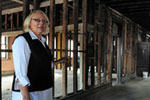
Linda Alworth of Gilpin points out a portion of a common area in the second floor of the future Lingrow Inn on Market Street in Leechburg. Jason Bridge | Valley News Dispatch
With its cracked walls, broken windows and dust-covered floors, any attempt to bring back a once-grand hotel on Leechburg’s Market Street would seem like an overwhelming task.
And then there are the ghosts.
It is a daunting task. The only way Linda Alworth can even approach it is one piece at a time.
“All this means nothing to me,” Alworth said recently as she looked around the dark area of the gutted building that will soon become a pub. “I can see it finished. I take one small area of it at a time.”
Alworth’s $2.2 million project to turn the 110-year-old building at 127 Market St. into the Lingrow Inn is moving into high gear. She expects a first-floor restaurant and bar to be open for business early next year.
During its life, the building has carried many names. In the 1920s, it was the National Hotel, and home to a pharmacy.
“We want to try to bring it back to the way it was, with a new fling,” Alworth said.
Borough council President Tony Defilippi’s grandfather, Joseph Defilippi, owned the hotel. He has a photograph of the hotel lobby with his grandfather, who died in 1925, behind the registration desk.
“It will be very nice to see the hotel being used again. I hope to see the entire building be renovated soon,” Defilippi said. “It adds a lot to the downtown area.”
David Farkas, director of the Main Street program for the Pittsburgh History and Landmarks Foundation, called the project important not just for Leechburg, but for the entire region.
“When the project is complete, there will be an expanded dining offering in Leechburg (and) a place for people to stay who are visiting the area to take advantage of all the outdoor activities that are possible here in the Kiski Valley,” he said. “It will allow people who are visiting or here for special events or weddings to stay close by in Leechburg. We expect that to have an impact on the surrounding businesses in Leechburg and the whole area.”
In Defilippi’s old photo, a grand staircase leads up to the second floor. The hotel section of the building has been closed off for nearly 40 years, although the first floor has been home to various bars and restaurants in subsequent years. The roof had a bad leak, and there has been significant damage to the upper floors of the four-story building.
Closed off behind a wall and tiny doorway, the stairs are part of the charm Alworth plans to bring back.
“It will be grand. I can see the bride walking down the staircase,” Alworth said.
Hard work and tackling big projects come naturally to Alworth, a 56-year-old Gilpin resident who turned an 1850s barn in Gilpin into Lingrow Farm, one of the region’s top wedding venues. It was rated by local brides as a “best of weddings” pick for Southwestern Pennsylvania by the wedding magazine The Knot.
A granddaughter of immigrants from Poland and Germany, Alworth was one of five children who grew up on her family’s farm in Washington Township. Her father didn’t believe in sending girls to college.
“You have to believe in yourself. If you don’t believe in yourself, you’re never going to do anything,” she said. “How do you get things done? You do it. You don’t talk about it.”
Alworth started a landscaping business, Lingrow Landscaping, 17 years ago. She bought the farm at an auction six years ago and the event center is now in its fourth year of hosting weddings.
The inn will serve the farm with food and a place for guests to stay, once its 27 planned rooms are completed. But Alworth sees the building as serving the borough as well.
“I love this town. I love the people in the town. I believe in the businesses here. I believe they can do so much more,” she said. “I really want more business to come into Leechburg. This will be an anchor building.”
Alworth had a feasibility study done.
“We need places for people to stay and not just for the farm. We found out there is a real need,” she said. “We have the river. We have the kayaking now. We have great stores. We’ve been left in the dust long enough.”
Alworth paid $100,000 for the building in May 2009.
The economy has not been her friend. Getting the financing to do the work was not easy, and there were times Alworth thought it would never come and she’d be best to unload the building. But the financing finally came together.
Loans and her own money are paying for the work.
She didn’t get any government handouts. There are no grants out there for a for-profit business, unless she did a full and even more costly historical restoration. She will benefit from a program that phases in the property taxes on the value of the improvements to the building over 10 years.
Alworth’s landscaping employees are now gutting the building.
The guys talk of hearing people walking around upstairs. They’ve heard someone playing a piano that remains on the second floor. Sometimes the “ghost” is Alworth playing pranks, but other times…
They’ve removed the facade, exposing brick columns, and torn away plaster walls inside, exposing more warm brick.
They found an elegant arched doorway inside that had been covered up — and a significant crack near the front of the building. But Alworth says a structural engineer found the building to be in good condition, worthy of rehabilitation.
The restaurant and bar are coming first, to start a revenue stream. An architect is finishing plans, after which she’ll apply for building permits.
The bar, Olde Henry’s Pub, will be named for a brother, Henry Bazella, who lives in Georgia. Alworth says it will be like a New York bistro.
Most of the antiques of value in the building are long gone, but Alworth found a pile of solid old pub chairs – marked made in Poland – that she plans to have refurbished and use in the bar.
There’s an old cooler in the basement, where Alworth envisions a wine cellar.
The 90-seat restaurant will be named for her mother, Olive Bazella. The menu is a work in progress, but Alworth says the restaurant will serve healthy, good, affordable food.
“She was a wonderful cook, a wonderful mother,” Alworth said. “She’s probably looking down right now thinking, girl, you’re crazy.
“You have to be a little bit crazy,” she said.
-
Six Allegheny River Towns Picked to Receive Funding, Help
By Pittsburgh Tribune-Review
Monday, October 25, 2010
Last updated: 5:41 amSix local communities were chosen for a pilot project of the Pennsylvania Environmental Council to revitalize river towns with free professional services, work plans and tips on finding money to pay for the urban makeovers.
Millvale, Etna, Sharpsburg, Aspinwall, O’Hara and Blawnox are the first communities chosen for the countywide project.
The Pennsylvania Environmental Council is rolling out the Allegheny County River Towns Project to help communities visualize, analyze and identify redevelopment projects and to re-establish ties to the rivers.
The project is paid for by grants from two anonymous Pittsburgh foundations, said Jim Segedy, director of community planning at the nonprofit’s Pittsburgh office.
The Environmental Council has signed a memorandum of understanding with Allegheny County to help carry out its master plan, which includes redevelopment of the region’s riverfronts.
The six communities were picked for the project because they have begun redevelopment projects close to the Allegheny River, Segedy said.
“Millvale has its trail and waterfront park, Aspinwall has the marina, then there is the housing development in O’Hara,” said Segedy. All of these communities are part of the 17 river towns slated for a proposed trail along the Allegheny from Millvale to Freeport.
“This is not another study,” Segedy said. “We are looking for short-term action projects, prioritized projects to help improve the quality of life in these towns and help with storm water management, water quality flood protection and economic development.”
What that means is that the Environmental Council will provide — free of charge to the communities — architects, engineers, landscape architects, planners and other professionals to assess the towns and come up with ideas.
“It’s a great way for the communities to look at their assets and do it in a unified, collaborative way,” said John Stephen, executive director of the Allegheny River Towns Enterprise Zone. “And that will improve the chances to bring in grants and resources,” he added.
Community input is critical, Segedy said.
“This is their communities and we want to do what they think we need and we want. We’re not from the government, we want to help,” he said.
After walk-throughs in all six communities next month, the council will hold public meeting in December for residents to talk about what their ideas are for improvement in the towns.
Then the council will provide a list of prioritized projects, directing the local governments to grants and other resources to jump start redevelopment projects, Segedy said.
“Shovels should hit the ground in the spring for some of these projects,” he said.

